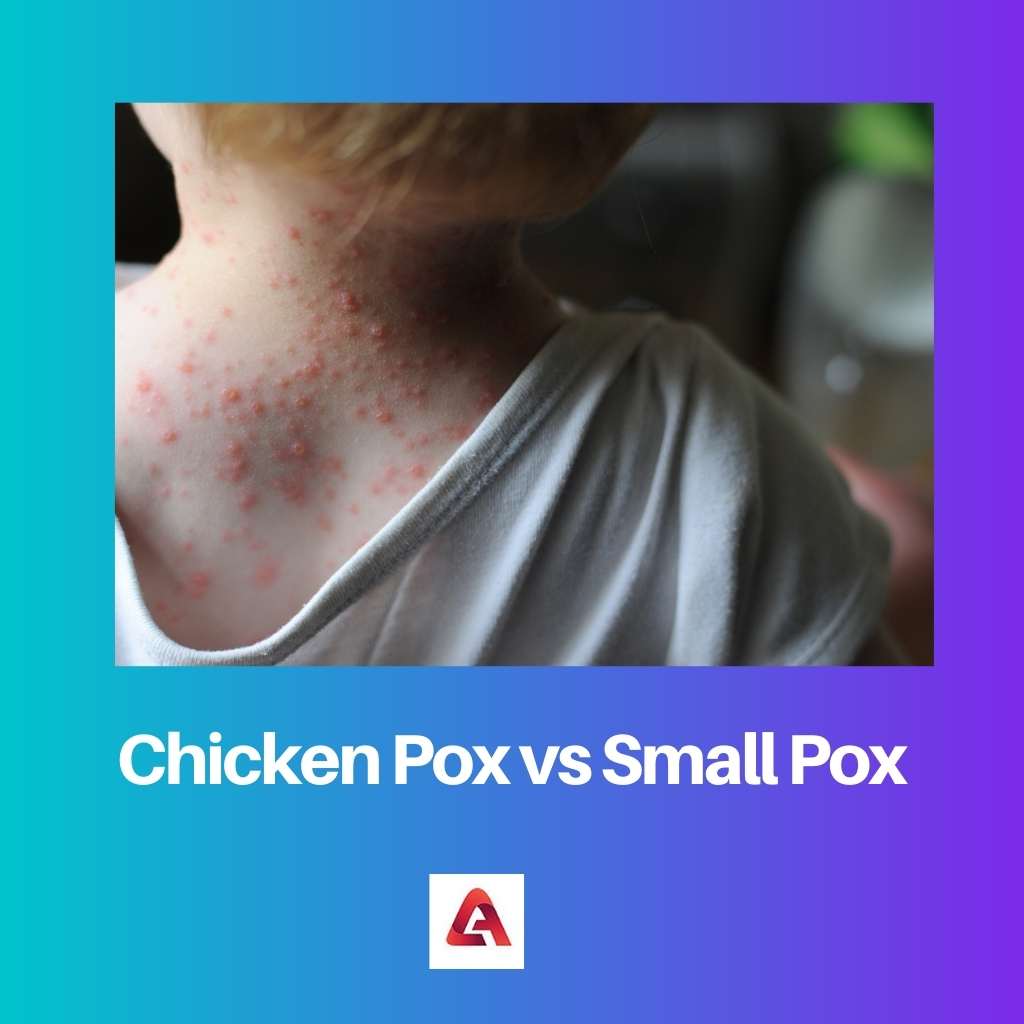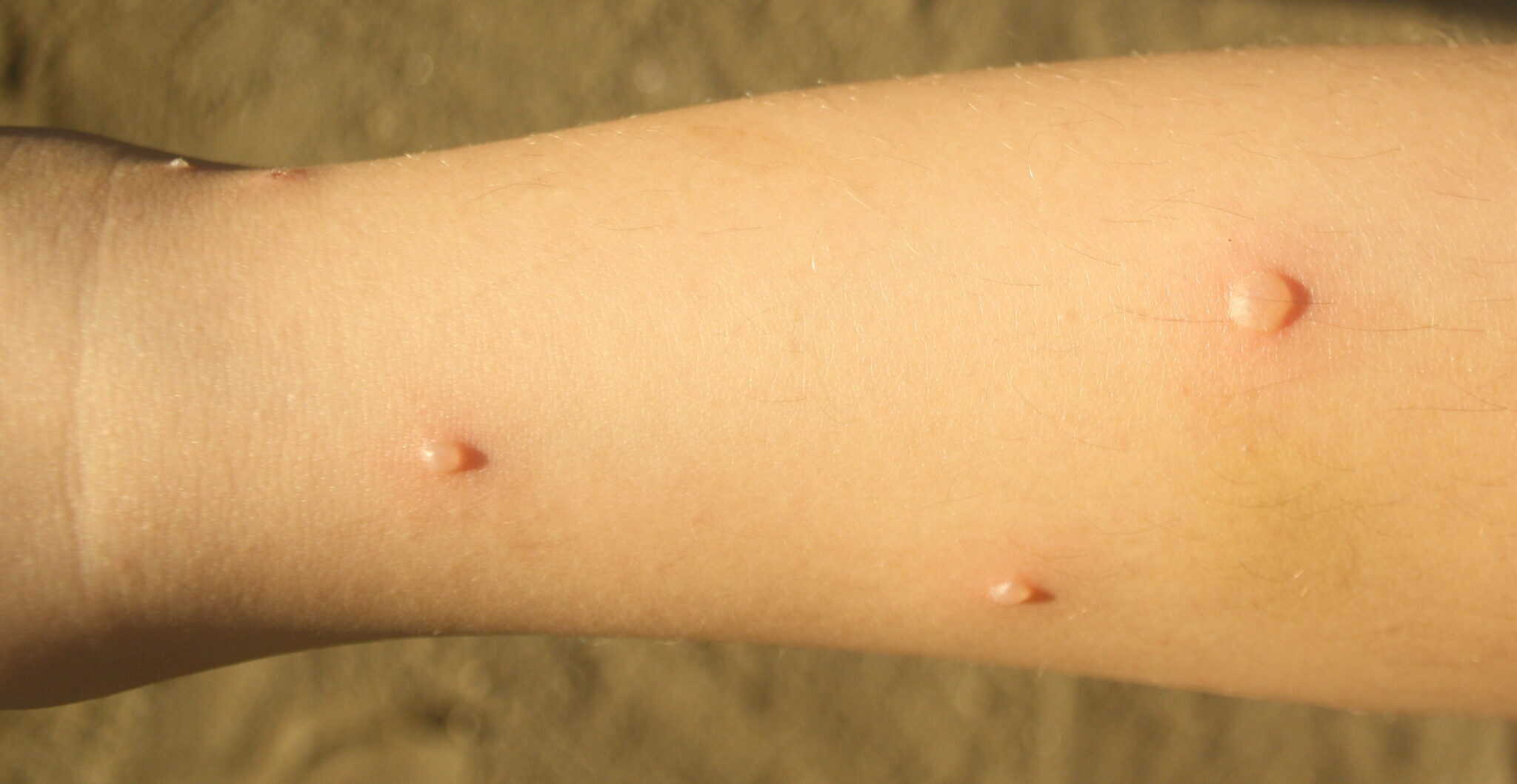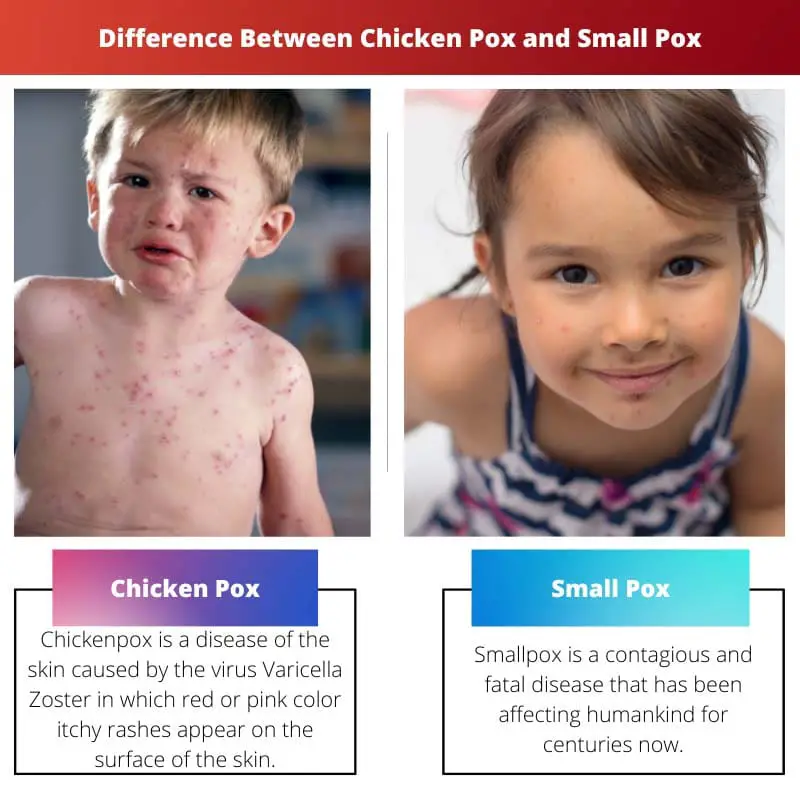In humans, disease and disorders are very common, which is why children are vaccinated since their birth to prevent them from deadly diseases.
One such deadly disease is smallpox which is not seen these days but is capable of distorting a human’s face and chickenpox is similar to that but can be avoided by routine vaccination.
These two diseases are somewhat similar as their names have “pox” in them but are different.
Key Takeaways
- Chickenpox is a mild disease caused by the varicella-zoster virus, while smallpox is a severe, fatal disease caused by the variola virus.
- Chickenpox presents as small, itchy blisters, whereas smallpox produces large, fluid-filled bumps.
- Vaccination has eradicated smallpox, while chickenpox vaccines are widely available and recommended for children.
Chicken Pox v/s Small Pox
Chickenpox is caused by the varicella-zoster virus. The variola virus causes smallpox. Smallpox is a much more severe disease than chickenpox and can lead to serious complications, including death. Chickenpox is a relatively mild disease, while smallpox is a serious and deadly disease.

Chickenpox is a disease of the skin caused by the virus Varicella Zoster in which red or pink color itchy rashes appear on the surface of the skin.
These rashes start to appear from the trunk to the other parts of the body like the face and hands. Regular vaccination can help deal with chickenpox.
Smallpox, on the other hand, is a contagious and fatal disease that has been affecting humankind for centuries now. Oftentimes, people survive from smallpox, but these are some cases where it has proven to be almost always fatal.
Smallpox is very rarely seen and is capable of distorting the face of a person.
Comparison Table
| Parameters of Comparison | Chicken Pox | Small Pox |
|---|---|---|
| Incubation period | 10 to 21 days. | 7 to 17 days. |
| Distribution | Lesions develop on the trunk of the body in the initial stage. | Lesions develop on the face in the initial stage. |
| Virus | Varicella Zoster. | Variola |
| Development | The development rate Is rapid. | The development rate Is slow. |
| Death | Death associated with chickenpox is very uncommon. | Approx. 1 of every 10 people affected by smallpox die. |
What is Chicken Pox?
Chicken Pox is an infectious and viral disease caused by the Varicella Zoster virus. In this disease, the body of the patient suffers from itchy rashes and blisters on the skin.
Chicken Pox is considered to be a contagious disease that affects people who are not vaccinated but is self-treatable.
Chicken Pox can spread easily from one person to another through saliva, contact with contaminated surfaces, inherited from the mother, etc.
The US Centre for Disease Control and Prevention recommends taking regular vaccines for preventing any symptoms of chickenpox.
It takes up to 10 to 21 days for the itchy rashes and blisters to appear in the body when a person is exposed to the chickenpox virus and these symptoms last up to 5 to 10 days.
Other than these symptoms, people with chickenpox also suffer from fever, not feeling hungry, headache, feeling lethargic, tired, etc. Once the rash appears on the skin, it goes through three stages:
- Red or pink raised bumps, which appear over for several days.
- Small blisters filled with fluids, which are created in a day and then splints.
- Crusts and scans, which mask the splintered blisters.
Bumps may continue to come up in the skin for many days, so you may experience all three stages at the same time. A person diagnosed with chickenpox can infect the other person with 48 hours of being infected.

What is Small Pox?
Smallpox is a contagious disease caused by the Variola virus, which affects humans for centuries. This disease was exterminated in the year 1980 but, some samples for the Variola virus have been preserved for research purposes.
No direct cure, medication, or treatment exists for smallpox, but vaccination can prevent smallpox.
Routine vaccination is not recommended for people who have the possibility of low-risk percentage from the smallpox virus, as the side effects of the vaccination are extremely high.
During 7 to 17 days of incubation, the person looks healthy and cannot infect others. After the incubation period, some signs and symptoms start to occur which include: fever, discomfort, pain in the back, nausea, severe fatigue, etc.
After some days, red spots start to appear on the face, forearms, and hands and then spread onto your trunk areas.
The virus can spread from a direct prolonged contact with the infected person, or in some cases, the virus flew as an airborne virus through the ventilation system and infects others.
It can also spread through contaminated items, although the risk factor is a lot less. People do recover from this deadly disease but are left with deep, dark scars all over their bodies.
Main Differences Between Chicken Pox and Small Pox
- Chicken Pox is caused by the Varicella Zoster virus while smallpox is caused by the Variola virus.
- The Incubation period of chickenpox is 14 to 21 days, while the incubation period of smallpox is 7 to 17 days.
- In chickenpox, scabies from between 4 to 7 days, whereas, in smallpox, the scans form between 10 to 14 days.
- In chickenpox, the rashes start to appear in the trunk of the body and then spread to the face whereas, in smallpox, the rash initially please on the face and then spreads to the stomach part.
- The death rate in chickenpox is very uncommon almost negligible whereas, in smallpox, the mortality rate is 30%.

- https://www.ncbi.nlm.nih.gov/pmc/articles/pmc2317118/
- https://www.ncbi.nlm.nih.gov/pmc/articles/PMC2303983/

That was very enlightening. I learned a lot!
I agree, a very well-structured comparison of the two diseases.
A very important article that helped me better understand the differences between chickenpox and smallpox.
This was really an eye-opener. I’m very impressed.
Very informative and useful post. Thanks for sharing!
This article is great. I just wish it had touched more on the social impact of these diseases.
What a shame indeed. That aspect was overlooked.
Yes, it’d be interesting to see that.
I am grateful for this highly insightful post.